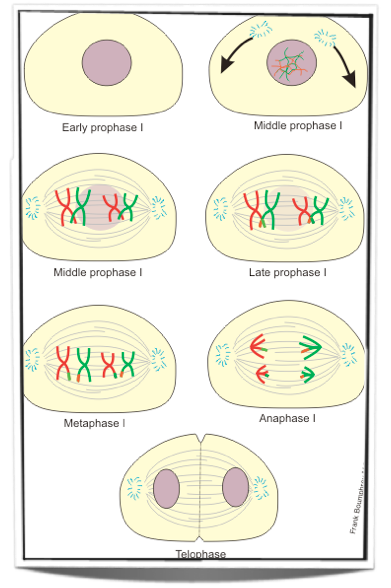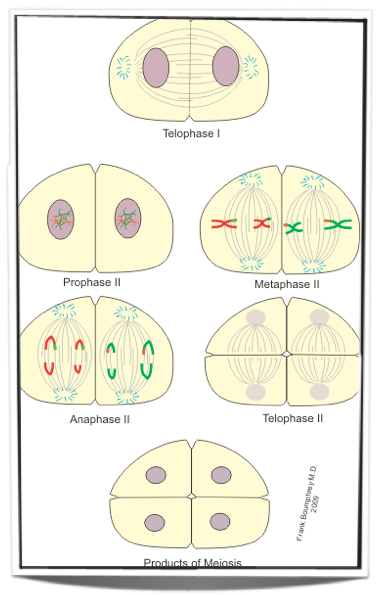Meiosis
10.1.1 Describe the behaviour of the chromosomes in the phases of meiosis.
Two divisions occure during meiosis, these are termed meiosis I and meiosis II. Each division involves the four stages of prophase, metaphase, anaphase and telophase.
Meiosis I
Prophase I
- Chromosomes coil up tightly and become visible under a light microscope
- Homologous chromosomes pair up and crossing over occures (the point of cross over is known as the chiasma)
- Nuclear membrane disintgrates and the centrioles travel to the poles of the cell
Metaphase I
- Microtubules form a spindle and the spindle fibers attach to the centromeres of the chromosomes
- Pairs of homologous chromosomes align along the equator
Anaphase I
- Spindle fibers shorten pulling paired homologous chromosomes in opposite directions
- Paired homologous chromosomes are seperated and pulled to opposite poles so that each pole contains one chromosome of each pair.
Telophase I
- A nuclear membrane forms around the chromosomes at each pole and chromosomes uncoil
- The cell undergoes cytokinesis to form two daughter cells
- Forms two haploid cells
- At the end of telophase I the cells may enter a short interphase period or proceed directly to meiosis II
- DNA is not replicated

Figure 10.1.1 - Meiosis I
Meiosis II
Prophase II
- Chromosomes coil up again
- Centrioles move to the cell poles
- Nuclear membrane disintergrates
Metaphase II
- Spindle fibers attach to the the centromeres
- Chromosomes align along the equator
Anaphase II
- Spindle fibers shorten
- Centromeres split
- Chromatids of each chromosome travel to opposite poles
Telophase II
- Nuclear membrane forms around the chromatids at each pole, once the membrane is formed, each chromatid is then called a chromosome.
- Both cells undergo cytokinesis to form four cells
- Chromosomes uncoil
- Nucleoli form

Figure 10.1.2 - Meiosis II
10.1.2 Outline the formation of chiasmata in the process of crossing over.
In prophase I the four sister chromatids of a pair of homologous chromosomes become tightly linked in a process called synapsis. A cut is made in the DNA molecule of one of the chromatids. Following this another cut is made at the same point in the DNA molecule of a non-sister chromatid. The DNA of the one chromatid binds to the DNA of the non-sister chromatid. Paternal and maternal chromosomes can then exchange genetic material. This is called crossing over. Once crossing over is finnished the homologous chromosomes are no longer tightly linked however the connection between the non-sister chromatids remains, forming an X - shaped structure called a chiasma. The chiasma links homologous chromosome pairs together and remains until late metaphase I.
10.1.3 Explain how meiosis results in an effectively infinite genetic variety in gametes through crossing over in prophase I and random orientation in metaphase I.
Two processes result in the infinite genetic variety in gametes. These are crossing over in prophase I and the random orientation of chromosomes in metaphase I.
Crossing over is important for genetic variety as it allows the exchange of genetic material between the maternal and paternal chromosomes. This forms chromatids with new combinations of alleles (recombination of linked genes). The chromatids which have a combination of allele different to that of either parent are called recombinants. It is also important to note that crossing over occures at a random point and more than one chiasma can form per homologous pair. This means that meiosis can result in almost an infinite amount of genetic variety.
The random orientation of homologous chromosomes at the equator in metaphase I also plays a vital role in genetic variety. Since the homologous pairs of chromosomes are orientated randomly at the equator, either maternal or paternal homolgue can orient towards either pole. The number of possible orientations is equal to 2 raised to the power of the number of chromosome pairs. For example, for a haploid number of n, 2n is the number of possible outcomes. Humans have a haploid number of 23. 223 gives a value of over 8 million. This means that there are over 8 million possible combinations just through the radom orientation of the homologous chromosmes. If we add the effects of crossing over, the number of combinations increases even further. Therfore, these two processes allow infinit genetic variety in gametes.
10.1.4 State Mendel?s law of independent assortment.
Allele pairs seperate independently during gamete formation which means that the transmission of traits to offspring are independent to one another.
10.1.5 Explain the relationship between Mendel?s law of independent assortment and meiosis.
During metaphase I of meiosis the homologous pairs of chromosomes align along the equator. The orientation of the chromosomes is random. This means that when the pairs of homologous chromosomes move to opposite poles during anaphase I, either chromosome can end up at either pole. This depends on which way the pair is facing (occurs randomly). Also, which ever way the pair is facing does not affect which way the other homologous chromosome pairs are facing. This is known as idenpendent orientation and forms the basis of Mendel's law of independent assortment. Unlinked genes are found on different chromosomes so when the homologous chromosome pairs seperate it allows the formation of daughter cells with random assortemnets of chromosomes and alleles.
